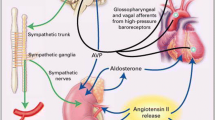Abstract
The arterial baroreflex is an important determinant of the neural regulation of the cardiovascular system. It has been recognised that baroreflex-mediated sympathoexcitation contributes to the development and progression of many cardiovascular disorders. Accordingly, the quantitative estimation of the arterial baroreceptor-heart rate reflex (baroreflex sensitivity, BRS), has been regarded as a synthetic index of neural regulation at the sinus atrial node. The evaluation of BRS has been shown to provide clinical and prognostic information in a variety of cardiovascular diseases, including myocardial infarction and heart failure that are reviewed in the present article.
Similar content being viewed by others
References
Bristow JD, Honour AJ, Pickering TG, et al. Cardiovascular and respiratory changes during sleep in normal and hypertensive subjects. Cardiovasc Res. 1969;3:476–85.
Eckberg DL, Drabinsky M, Braunwald E. Defective cardiac parasympathetic in patients with heart disease. New Engl J Med. 1971;285:877–83.
Kent KM, Smith ER, Epstein SE. Electrical stability of acutely ischemic myocardium. Influences of heart arte and vagal stimulation. Circulation. 1973;47:291–8.
Kliks BR, Burgess MJ, Abildskov JA. Influence of sympathetic tone on ventricular fibrillation threshold during experimental coronary occlusion. Am J Cardiol. 1975;36:45–9.
Schwartz PJ, Pagani M, Lombardi F, et al. A cardiocardiac sympatho-vagal reflex in the cat. Circ Res. 1973;32:215–20.
Schwartz PJ, Vanoli E, Stramba-Badiale M, et al. Autonomic mechanisms and sudden death. New insights from analysis of baroreceptor reflexes in conscious dogs with and without a myocardial infarction. Circulation. 1988;78:969–79.
Smith ML, Kinugawa T, Dibner-Dunlap ME. Reflex control of sympathetic activity during ventricular tachycardia in dogs. Primary role of arterial baroreceptors. Circulation. 1996;93:1033–42.
La Rovere MT, Bigger Jr JT, Marcus FI, et al. Baroreflex sensitivity and heart rate variability in prediction of total cardiac mortality after myocardial infarction. Lancet. 1998;351:478–84.
La Rovere MT, Pinna GD, Hohnloser SH, et al. Baroreflex sensitivity and heart rate variability in the identification of patients at risk for life-threatening arrhythmias. Implications for clinical trials. Circulation. 2001;103:2072–7.
Landolina M, Mantica M, Pessano P, et al. Impaired baroreflex sensitivity is correlated with hemodynamic impairment of ventricular tachycardia. J Am Coll Cardiol. 1997;29:568–75.
De Ferrari GM, Sanzo A, Bertoletti A, et al. Baroreflex sensitivity predicts long-term cardiovascular mortality after myocardial infarction even in patients with preserved left ventricular function. J Am Coll Cardiol. 2007;50:2285–90.
Mortara A, La Rovere MT, Pinna GD, et al. Arterial baroreflex modulation of heart rate in chronic heart failure. Circulation. 1997;96:3450–8.
La Rovere MT, Pinna GD, Maestri R, et al. Prognostic implications of baroreflex sensitivity in heart failure patients in the beta-blocking era. J Am Coll Cardiol. 2009;53:193–9.
Pinna GD, Maestri R, Capomolla S, et al. Applicability and clinical relevance of the transfer function method in the assessment of baroreflex sensitivity in heart failure patients. J Am Coll Cardiol. 2005;46:1314–21.
La Rovere MT, Maestri R, Robbi E, et al. Comparison of the prognostic value of invasive and noninvasive assessment of baroreflex sensitivity in heart failure. J Hypertens. 2011;29:1546–52.
Sarzi-Braga S, La Rovere MT, Pedretti RF. Baroreflex sensitivity normalization after cardiac resysnchronization therapy. Intern J Cardiol. 2006;109:118–20.
Piepoli MF, Villani GQ, Corrà U, et al. Time course of the effects of cardiac resysnchronization therapy in chronic heart failure: benefits in patients with preserved exercise capacity. Pacing Clin Electrophysiol. 2008;31:701–8.
Gademan MG, van Bommel RJ, Ypenburg C, et al. Biventricular pacing in chronic heart failure acutely facilitates the arterial baroreflex. Am J Physiol Heart Circ Physiol. 2008;295:H755–60.
Gademan MG, van Bommel RJ, Borleffs CJ, et al. Biventricular pacing-induced acute response in baroreflex sensitivity has predictive value for midterm response to cardiac resynchronization therapy. Am J Physiol Heart Circ Physiol. 2009;297:H233–7.
Bauer A, Malik M, Schmidt G, et al. Heart rate turbulence: standard of measurements, physiological interpretation, and clinical use: International Society for Holter and Noninvasive Electrophysiology Consensus. J Am Coll Cardiol. 2008;52:1353–65.
Mrowka R, Persson PB, Theres H, et al. Blunted arterial baroreflex causes “pathological” heart rate turbulence. Am J Physiol Regul Integr Comp Physiol. 2000;279:1171–5.
La Rovere MT, Maestri R, Pinna GD, et al. Clinical and haemodynamic correlates of heart rate turbulence as a non-invasive index of baroreflex sensitivity in chronic heart failure. Clin Sci (Lond). 2011;121:279–84.
La Rovere MT, Pinna GD, Maestri R, et al. Autonomic markers and cardiovascular and arrhythmic events in heart failure patients: still a place in prognostication? Data from the GISSI-HF trial. Eur J Heart Fail 2012; Jul 30, Epub ahead of print
Disclosures
The author has no conflict of interest to declare.
Author information
Authors and Affiliations
Corresponding author
Rights and permissions
About this article
Cite this article
La Rovere, M.T., Pinna, G.D., Maestri, R. et al. Clinical value of baroreflex sensitivity. Neth Heart J 21, 61–63 (2013). https://doi.org/10.1007/s12471-012-0349-8
Published:
Issue Date:
DOI: https://doi.org/10.1007/s12471-012-0349-8




